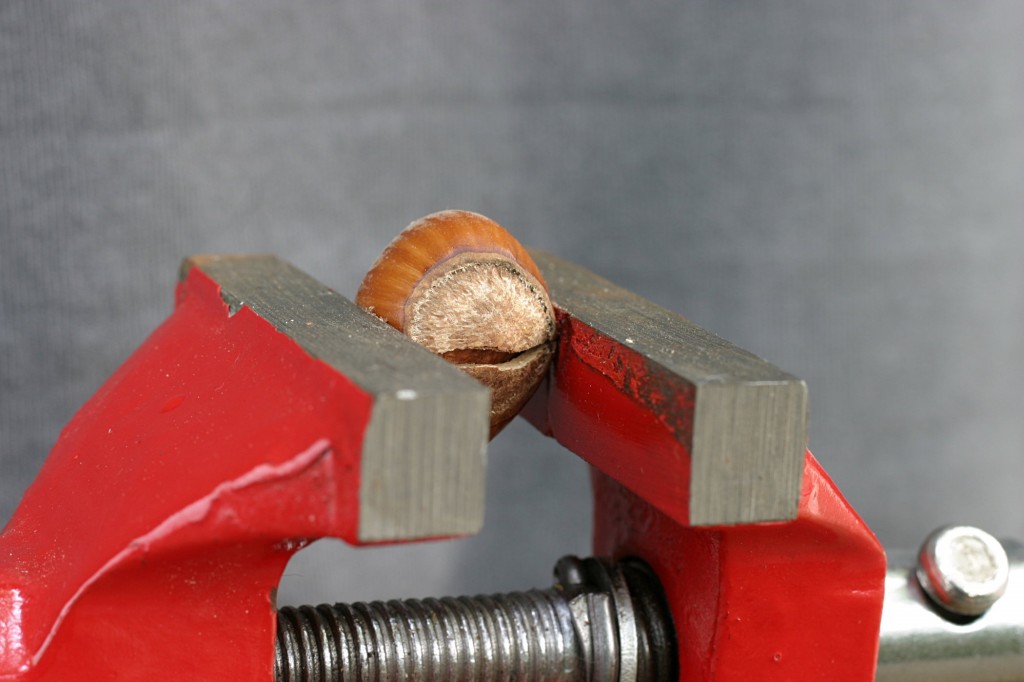Imagine this nut is your head. And this vice . . . is a migraine.
According to Migraine.com, “In the U.S., more than 37 million people suffer from migraines. Some migraine studies estimate that 13 percent of adults in the U.S. population have migraines, and 2-3 million migraine suffers are chronic. Almost 5 million in the U.S. experience at least one migraine attack per month, while more than 11 million people blame migraines for causing moderate to severe disability.”
I have been battling migraines since my early twenties. Unfortunately, as I get older, my migraines have gotten more frequent and more debilitating. In fact, today, I had one while on vacation with my family and had to be left behind in a darkened hotel room with ear plugs in place and a sign on the door, no housekeeping please. It’s not the first time I’ve missed out on something with the kids because, “Mommy has a headache today,” and I’m sure it won’t be the last.
“Take some Excedrin and get back to business.” If only it were that simple. If you get migraines or know someone who does, you understand that over-the-counter pain relievers do not even make a dent in the pain. Sometimes Hydrocodone can knock me out long enough for the migraine to pass, and a couple times a shot of morphine at the ER has done the trick.
Preventive medicine has had mixed results. For a while I was taking Topimax (normally prescribed for folks who suffer from seizures) . It worked at keeping the migraines at bay, but the side effects were miserable: kidney stones and liver cysts, hallucinations, tingling hands and feet, and horrific brain fog. They don’t call it “Dopimax” for nothing. When I first started taking it, I snapped out of one stupor to find I’d been brushing my teeth for twenty minutes. Despite my uber-white smile, I decided to trade out the Topimax for rational thought.
These days I’ve been managing with daily high doses of magnesium and Vitamin D and Imitrex shots and pills. It works. But only if those shots and pills are timed just right. If I don’t catch the migraine when it first starts, I just end up with the dizzy, racing-heart side effects of the medication on top of the migraine pain.
A strategy that has been semi-successful is the headache diary. It’s been helpful to keep a log of the things that I’ve eaten and the things I’ve done on the days preceding and during a migraine. The result? A crazy-long list of headache triggers, which I share with you now in no particular order:
Dehydration, Aspartame, Sucralose, Alcohol (especially wine and beer), Flashing lights, Wearing 3D glasses, Monosodium Glutamate, More than 26 mg of caffeine in 24 hours, Grape juice, Monthly hormone fluctuations, the Summer Solstice, the Winter Solstice, Cigarette smoke, Staying out in the hot sun for 5+ hours at temps greater than 90 degrees Fahrenheit, Sinus infections, Mold, Not eating for 10+ hours, Stress lasting multiple consecutive days, Vigorous workouts, Pinching neck nerves, Lima beans.
OK, lima beans don’t trigger my migraines. I just hate their nastiness and avoid them at all costs.
So, some of these triggers are completely within my control and I successfully avoid them. And others, not so much. As an Earthling, it’s a bit difficult to avoid the solstices.
If you have a migraine sufferer in your life you can help by listening and avoiding insensitive comments such as, “It’s just a headache” or “Get some sunshine and fresh air” or “Reduce the stress in your life” or “have you tried XYZ? It worked for a friend of mine”. Because a migraine is not just a headache, and going outside can often be a trigger or exacerbate the pain, and even a stress-free, meditation-filled, yoga lover will still suffer from migraines, and chances are, the person has been afflicted with migraines for decades and has tried everything. Every. Thing.
Hypnosis. Been there. Acupuncture. Done that. Biofeedback. Yep. Drugs. Tends to be the first recommendation from the medical professionals, so, yes. And too many other “remedies” to mention.
The best thing I’ve done recently for myself is find a doctor who specializes in migraine treatment. It’s nice to have a physician who speaks the language of migraines. It’s nice to have a physician who doesn’t look at me like I’m a nut when I tell him I can’t drive underneath the canopy of a tree-line road while the sun is shining. “Perfectly understandable,” he says. “I bet you can’t watch the new Transformers movie in IMAX 3D either.”
Photo © Robert Faric


